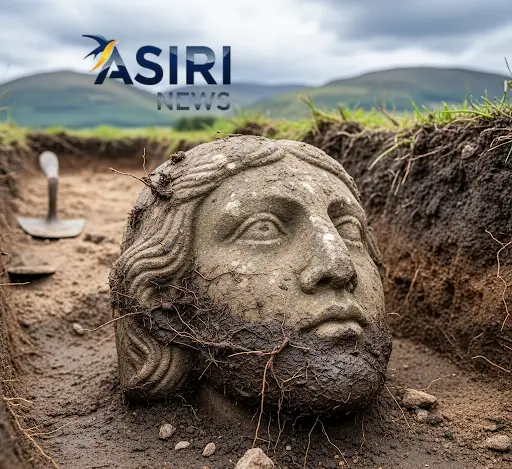In a discovery that is captivating the archaeological world, a finely carved medieval sandstone head has been unearthed at Skaill Farm on the island of Rousay in Orkney, Scotland. The rare artifact was found by archaeology student Katie Joss during a field excavation and is already reshaping our understanding of the region’s medieval past. Its exquisite craftsmanship and serene expression stand in stark contrast to the rougher, non-representational finds typically made in the area, offering compelling evidence of a high-status ecclesiastical structure that once stood nearby.

The figure, which features finely sculpted curly hair, closed eyes, and a slight, enigmatic smile, is believed to be a piece of a larger architectural carving from a high-status Norse kirk (church) that predated the existing St. Mary’s parish church. The stone itself—a rich red sandstone with yellow inclusions—is believed to have been quarried from the nearby island of Eday, a source that matches other fragments of high-quality masonry found at the site. The head’s artistry has drawn intriguing comparisons to medieval carvings at the iconic St Magnus Cathedral in Kirkwall, suggesting a shared artistic tradition and network of masons between the two sites. One researcher even noted that the curl of hair on the Skaill head appears as a mirror image of a similar carving on the cathedral, hinting at a direct connection.
The excavation at Skaill Farm, a long-term research project led by the University of the Highlands and Islands (UHI) Archaeology Institute, has been revealing a rich and layered history. The site sits directly atop the former settlement of Sigurd of Westness, a powerful 12th-century Viking chieftain. The discovery of the intricately carved head in a later deposit of rubble suggests that the former building was of considerable splendor and was likely dismantled and reused for later construction.
While the purpose of the head—whether it was part of a larger sculpture, a window frame, or a gargoyle—remains a fascinating enigma, its existence proves that Orkney was not just a remote outpost in the medieval era. The high-quality craftsmanship hints at a place of wealth and influence, and the find enriches our knowledge of the region’s spiritual and artistic life during a period often only understood through sagas and sparse historical records. The head will now be professionally preserved and is expected to go on public display, allowing this unique piece of Scotland’s past to be viewed by all.



